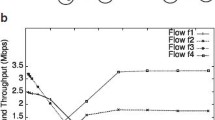Abstract
In heterogeneous wireless networks (HWNs), paths constituting multipath routing are characterized by selfish rationality. Each path’s intentions of pursuing individual profits may cause unreasonable competition for limited wireless resources, which leads to the unreliable data transport problem. Therefore, multipath routing optimization is a challenge issue in HWNs. This paper provides a novel approach to study this issue by employing game theory. By taking the utility maximization as the design goal, limited bandwidth resources as the constraint and path reliability as the key metric, a noncooperative stochastic differential game model is constructed for HWNs. With the feedback Nash equilibrium solution, an optimal multipath routing strategy is obtained. Theoretical derivations and simulation results verify the validity of the method present in this paper.









Similar content being viewed by others
References
Niyato, D., & Hossain, E. (2009). Dynamics of network selection in heterogeneous wireless networks: An evolutionary game approach. IEEE Transaction on Vehicular Technology, 58(4), 2008–2017.
Xu, C., Liu, T., Guan, J., Zhang, H., Zhang, H., & Muntean, G. (2013). CMT-QA: Quality-aware adaptive concurrent multipath data transfer in heterogeneous wireless networks. IEEE Transaction on Mobile Computing, 12(11), 2193–2205.
Chebrolu, K., & Rao, R. R. (2006). Bandwidth aggregation for real-time applications in heterogeneous wireless networks. IEEE Transaction on Mobile Computing, 5(4), 388–403.
Marina, M. K., & Das, S. R. (2001). On-demand multipath distance vector routing in ad hoc networks. In Proceedings of the 9th international conference on network protocols, pp. 14–23.
Sha, K., Gehlot, J., & Greve, R. (2013). Multipath routing techniques in wireless sensor networks: A survey. Wireless Personal Communications, 70(2), 807–829.
De Couto, D. S. J., Aguayo, D., et al. (2005). A high-throughput path metric for multi-hop wireless routing. Wireless Networks, 11(4), 419–434.
Roy, S., Koutsonikolas, D., Das, S., et al. (2008). High-throughput multicast routing metrics in wireless mesh networks. Ad Hoc Networks, 6(6), 878–899.
Draves, R., Padhye, J., & Zill, B. (2004). Routing in multi-radio, multi-hop wireless mesh networks. In Proceedings of the 10th annual international conference on mobile computing and networking, pp. 114–128.
Zorzi, M., & Rao, R. R. (2003). Geographic random forwarding (GeRaF) for ad hoc and sensor networks: Energy and latency performance. IEEE Transactions on Mobile Computing, 2(4), 349–365.
Zeng, K., Lou, W., Yang, J., & III Brown, D. R. (2007). On throughput efficiency of geographic opportunistic routing in multihop wireless networks. Mobile Networks and Applications, 12(5), 347–357.
Radi, M., Dezfouli, B., Abu Bakar, K., Abd Razaka, S., & Nematbakhshb, M. A. (2011). Interference-aware multipath routing protocol for QoS improvement in event-driven wireless sensor networks. Tsinghua Science and Technology, 16(5), 475–490.
Yeung, D. W. K., & Petrosyan, L. A. (2005). Cooperative stochastic differential games. New York: Springer.
Zhou, X., Cheng, Z., Ding, Y., et al. (2012). A optimal power control strategy based on network wisdom in wireless networks. Operations Research Letters, 40(6), 475–477.
Xu, H., Zhou, X., & Chen, Y. (2013). A differential game model of automatic load balancing in LTE networks. Wireless Personal Communications, 71(1), 165–180.
Wang, X., Zhou, X., & Song, J. (2012). Transmission power control and routing strategy based on differential games in deep space exploration. Wireless Personal Communications, 67, 895–912.
Miao, X., Zhou, X., & Huayi, W. (2010). A cooperative differential game model based on transmission rate in wireless networks. Operations Research Letters, 38(4), 292–295.
Lin, L., Xianwei, Z., Liping, D., et al. (2009). Differential game model with coupling constraint for routing in ad hoc networks. In Proceedings of the 5th international conference on wireless communication, networking and mobile computing, pp. 3042–3045.
Tao, M., Lu, D., & Yang, J. (2012). An adaptive energy-aware multi-path routing protocol with load balance for wireless sensor networks. Wireless Personal Communications, 63(4), 823–846.
Weeraddana, P. C., Codreanu, M., & Latva-aho, M. (2011). Resource allocation for cross-layer utility maximization in wireless networks. IEEE Transactions on Vehicular Technology, 60(6), 2790–2809.
Abdur Razzaque, M., & Mamun-Or-Rashid, M. (2009). Aggregated traffic flow weight controlled hierarchical MAC protocol for wireless sensor networks. Annals of Telecommunications, 64(11–12), 705–721.
Kelly, F. P., Maulloo, A. K., & Tan, D. K. H. (1998). Rate control for communication networks: Shadow prices, proportional fairness and stability. Journal of the Operational Research Society, 49(3), 237–252.
Li, Z., & Wang, R. (2010). Load balancing-based hierarchical routing algorithm for wireless multimedia sensor networks. The Journal of China Universities of Posts and Telecommunications, 17(Suppl. 2), 51–59.
Pham, P. P., & Perreau, S. (2004). Increasing the network performance using multi-path routing mechanism with load balance. Ad Hoc Networks, 2, 433–459.
Grosu, D., Chronopoulos, A. T., & Ming-Ying, L. (2002). Load Balancing in distributed systems: An approach using cooperative games. In Proceedings of international parallel and distributed processing symposium (IPDPS 2002), Ft. Lauderdale, FL, USA.
Grosu, D., & Chronopoulos, A. T. (2005). Noncooperative load balancing in distributed systems. Journal of Parallel and Distributed Computing, 65(9), 1022–1034.
Bodlaender, H. L., Thomassé, S., & Yeo, A. (2011). Kernel bounds for disjoint cycles and disjoint paths. Theoretical Computer Science, 412(35), 4570–4578.
Shannon, C. E. (2001). A mathematical theory of communication. ACM SIGMOBILE Mobile Computing and Communications Review, 5(1), 3–55.
Razzaque, M. A., Alam, M. M., Mamun-or-Rashid, M., & Hong, C. S. (2008). Multi-constrained QoS geographic routing for heterogeneous traffic in sensor networks. IEICE Transaction on Communications, E91–B(8), 2589–2601.
Acknowledgments
The authors are grateful to the anonymous reviewer for constructive suggestions that have improved the quality of this paper. This work has been supported by the National Key Technology R&D Program of P. R. China (Grant No. 2011BAH10B03-1) and the National High-Tech Research and Development Program of P. R. China (Grant No. 2012AA121604).
Author information
Authors and Affiliations
Corresponding author
Appendices
Appendix 1: Proof of Corollary 1
Proof
Maximizing the right-hand-side of (10) for path-\(i\), and arranging the equation we get
For \(i = 1,2,\ldots ,n\), there is an system of linear equations
Summing over the right-hand-side and the left-hand-side respectively in (18), we get
There, we have two methods to obtain the solution of \(\phi _i^*\left( {t,x} \right) \). \(\square \)
Solution 1
Substituting (20) into (18), we get
Arranging (21), then
Solution 2
Letting (18) minus (20), we directly get
This completes the proof of Corollary 1.
Appendix 2: Proof of Corollary 2
Proof
From (14), we get
Substituting (22) into (11) produces
Meanwhile, substituting (22) into (13) produces
Thus
Let \(\Theta (t)=\left( {\lambda {-}\delta q_i } \right) \left( {f_i {+}\Gamma (t)\sum _{i=1}^n {g_i } } \right) -\left[ {\xi \left( {f_i {+}\Gamma (t)\sum _{i=1}^n {g_i } } \right) {+}\Gamma (t)} \right] \sum _{i=1}^n \Big ( f_i {+}\Gamma (t)\sum _{i=1}^n {g_i } \Big ),\)
Then
This completes the proof of Corollary 2. \(\square \)
Appendix 3: Derivation of (16)
Derivation Equation (15) is constituted by
and
It is noted that (15-1) is a homogeneous linear differential equation, while (15-3) is a nonhomogeneous linear differential equation, and both of them have their general solutions. The derivation of (16) is related to the solution process of linear differential equation. The derivation process is detailed as following:
Separate the variable of (15-1), we get
Integrate both sides of (26), we get
Then,
When \(t=T\),
Combining (28) and (15-2), we get
Let
be the solution of the nonhomogeneous linear differential equation (15-3).
Substitute \(\dot{\Lambda }(t)\) and \(\Lambda (t)\) into (15-3), then
Arrange (30), we get
Integrate both sides of (31), we get
Substitute (32) into (29), we get
When \(t=T\),
Combining (33) and (15-4), we get
Equations (16-1), (16-2), (16-3) and (16-4) constitute (16).
This completes the derivation of (16).
Appendix 4: Proof of Corollary 3
Proof
Solving the linear differential equation (9), we get
Substituting the optimal load-control strategy (24) into (34) produces
This completes the proof of Corollary 3. \(\square \)
Rights and permissions
About this article
Cite this article
Hu, J., Xie, Y. A Stochastic Differential Game Theoretic Study of Multipath Routing in Heterogeneous Wireless Networks. Wireless Pers Commun 80, 971–991 (2015). https://doi.org/10.1007/s11277-014-2065-8
Published:
Issue Date:
DOI: https://doi.org/10.1007/s11277-014-2065-8




